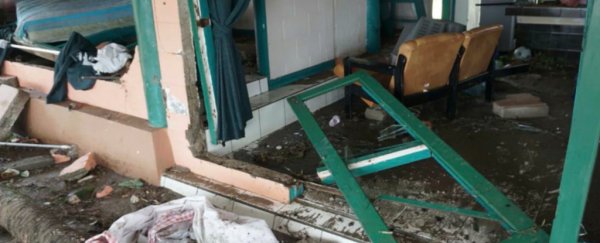At least 222 deaths have been reported in Indonesia on Sunday after a tsunami struck the Sunda Strait without warning, the latest disaster to befall a Pacific nation repeatedly stricken this year.
As of late Sunday, Indonesian government officials reported more than 843 injured and 28 still missing.
The cause remains unclear, but 1-meter high waves took coastal residents by surprise on Saturday evening without earthquake tremors that typically presage tsunamis — or any official warnings.
Indonesian officials downplayed the possibility that the nearby Krakatoa volcano, which has been erupting since June, caused the tsunami. Instead, experts said an undersea landslide may have generated massive waves without warning.
Over 500 buildings were destroyed or heavily damaged as waves poured in from the Sunda Strait, which separates Indonesia's two most populated islands, Java and Sumatra.
"Data collection is still ongoing. It's likely that the number of victims and damages will rise," said Sutopo Purwo Nugroho, spokesman for Indonesia's national disaster agency.
Beaches in the strait were reported heavily hit in places such as Pandeglang Regency, where 33 were reportedly killed, and Anyer and Tanjung Lesung beaches. At least nine hotels and dozens of restaurants and food stalls were badly damaged.
Government officials are warning tourists against visiting beaches along the strait.
Oystein Lund Andersen, a Norwegian witness who was on a family trip on the coast of the Anyer beach, wrote on Facebook that he was on a family trip when he saw the incoming wave. "Next wave entered the hotel area where I was staying and downed cars on the road behind it. Managed to evacuate with my family to higher ground through forest paths and villages, where we are taken care of by the locals. Were unharmed, thankfully," he wrote.
In a statement, Indonesian President Joko Widodo sent his condolences to those affected and said he dispatched emergency responders. Officials said heavy rescue equipment and emergency soup kitchens have been prepared. Oxfam said it was also dispatching help to the region.
Indonesia's volcanology and geology disaster mitigation center said there was an eruption of the Krakatoa on Saturday night. Although there was a "300 to 1500 meter" ash cloud reported above the crater's peak, the center said, it was unclear whether the tsunami was directly caused by the eruption.
Igan Sutawijaya, a volcano and geological disaster expert, said the Sunda Strait is a disaster-prone area but the waves may not be directly linked to an eruption.
"My suspicion is that there was an landslide under the sea. Perhaps a trench crumbled," he told The Washington Post in a phone interview. "It doesn't make sense that it was caused by the eruption of the Krakatoa."
Saturday's tsunami followed a string of disasters in Indonesia. Earthquakes and tsunamis have destroyed homes, killed and displaced thousands in areas such as the Lombok island in July and the Central Sulawesi city of Palu in September.
A Lion Air plane crash also killed over 189 people this autumn, leading experts to suggest the country was experiencing "disaster fatigue."
Indonesia sits on the seismically active "ring of fire" in the Pacific Ocean.
The Child of Krakatoa, an island that emerged in the 1920s after the 1883 volcanic eruptions of the Krakatoa, hosts one of Indonesia's most active eruption sites.
2018 © The Washington Post
This article was originally published by The Washington Post.
